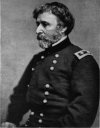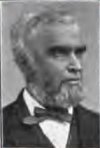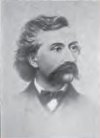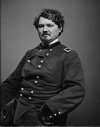Union Preparations at Lexington
 Back in July of 1861, the newly appointed Union Commander of the Western Department, Major General John C. Fremont had begun to consolidate Union control of the Missouri River. As part of this plan, Fremont established a garrison in Lexington, Missouri by sending the 5th Regiment of the United States Reserve Corps under the command of Colonel Charles Stifel from St. Louis, Missouri. This facilitated the recruitment of the Lafayette County Home Guard Regiment who elected Major F. W. Becker as their commander. Colonel Stifel and the 5th Regiment of the United States Reserve Corps returned to St. Louis later that month.
Back in July of 1861, the newly appointed Union Commander of the Western Department, Major General John C. Fremont had begun to consolidate Union control of the Missouri River. As part of this plan, Fremont established a garrison in Lexington, Missouri by sending the 5th Regiment of the United States Reserve Corps under the command of Colonel Charles Stifel from St. Louis, Missouri. This facilitated the recruitment of the Lafayette County Home Guard Regiment who elected Major F. W. Becker as their commander. Colonel Stifel and the 5th Regiment of the United States Reserve Corps returned to St. Louis later that month.
The 1st Illinois Volunteer Cavalry (about 700 cavalrymen) under the command of Colonel T.A. Marshall arrived in Lexington around the beginning of September. Marshall assumed command in Lexington and began preparing for the town's defense.
 On September 3rd, Colonel Everett Peabody commanding the 13th Missouri Volunteer Infantry (about 650 men) received orders to march from Kansas City, Missouri to Lexington, Missouri. He was accompanied by a U.S. Reserve Corps Infantry Battalion (about 150 men) under the command of Major R.T. Van Horn.
On September 3rd, Colonel Everett Peabody commanding the 13th Missouri Volunteer Infantry (about 650 men) received orders to march from Kansas City, Missouri to Lexington, Missouri. He was accompanied by a U.S. Reserve Corps Infantry Battalion (about 150 men) under the command of Major R.T. Van Horn.
 On September 5th, Union Brigadier General Lane sent word to Fort Leavenworth that Price was headed for Lexington:
On September 5th, Union Brigadier General Lane sent word to Fort Leavenworth that Price was headed for Lexington:
"I have just received information from the advance at Fort Scott that the enemy has broken up camp and is moving to the rear, and from a deserter that their destination is Lexington...If the move is upon Lexington, I will annoy them as far as my forces and the protection of Kansas will admit of."
Lane still believed Price was going to try and capture Fort Scott, although it turned out that Price had decided he had done enough against the Kansas Jayhawks and had set off for Lexington. On the same day the commanding officer at Fort Leavenworth, Captain W. E. Prince, sent orders to Colonel Everett Peabody, commanding the 13th Missouri Volunteer Infantry, to "proceed by forced marches to the aid of General Lane, taking the route either direct from Lexington or via the river and Kansas City." Lane's position was placed at Fort Lincoln about 12 miles north of Fort Scott. Peabody was already in Lexington when he received these orders. On his way to reinforce Lane's Kansas Brigade, Colonel Peabody encountered the advance units from Price's army near Warrensburg, Missouri on September 10th. Quickly realizing that he was hopelessly outnumbered, Colonel Peabody withdrew his regiment back to Lexington, Missouri.
 The 23rd Illinois Volunteer Infantry Regiment, with Colonel James A. Mulligan in command, arrived in Lexington from Jefferson City, Missouri on September 9th. Known as the "The Irish Brigade," Mulligan had raised the regiment in Chicago, Illinois.
The 23rd Illinois Volunteer Infantry Regiment, with Colonel James A. Mulligan in command, arrived in Lexington from Jefferson City, Missouri on September 9th. Known as the "The Irish Brigade," Mulligan had raised the regiment in Chicago, Illinois.
There was a meeting of the colonels, after which Mulligan assumed command of the garrison because he was the senior officer present. On September 11th Mulligan began fortifying his position by having his soldiers dig entrenchments. He would center his defense on the hill occupied by the Masonic College building.
On September 12, 1861, Mulligan's Commanding Officer in Jefferson City, Missouri, Colonel Jeff C. Davis, sent word to Union Major General John C. Fremont in St. Louis that Price was approaching Lexington with "ten or fifteen thousand men" and that Mulligan needed reinforcements.
 On September 14th, Fremont ordered Union Brigadier General Samuel Sturgis to proceed to Lexington in support of Mulligan.
On September 14th, Fremont ordered Union Brigadier General Samuel Sturgis to proceed to Lexington in support of Mulligan.
"You are hereby directed to move by way of Utica, with all practicable speed, to Lexington, on the Missouri River, with your force of infantry and artillery. You will send back the three companies of the Fremont Hussars, under Capt. Bloom, to Saint Louis. The most practicable route from Utica to Lexington for you will be by Austinville, Grove, and Morton."
Fremont replied back to Colonel Davis on September 14th:
"Re-enforcements will be sent you to-day. The Eighth Indiana left at 6 a. m. this morning for Jefferson City. Other regiments will follow to-day. Sturgis will move forward. We will telegraph you further respecting his movements. Gen. Pope, with some force, is at or near Saint Joseph."
Fremont sent the following orders to Colonel Davis on September 20th:
"Concentrate a force strong enough, in your judgment, at Georgetown, and push forward to relieve Mulligan. I trust that you can take provisions for two days with the means of transportation which you have. Order back your boats to Jefferson City, and send provisions and troops by them to Lexington. Two hundred wagons will be sent from here to-night to Syracuse. which will follow you. Troops are going from here."
There was going to be an engagement in Lexington and Fremont was doing all that was in his power to ensure a Union victory.
Back: The Battle of Dry Wood Creek
Next: The Siege at Lexington
